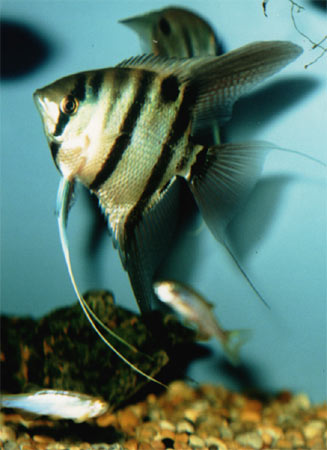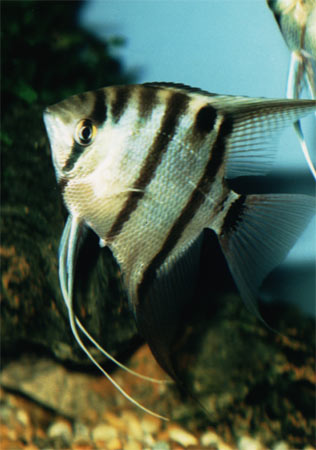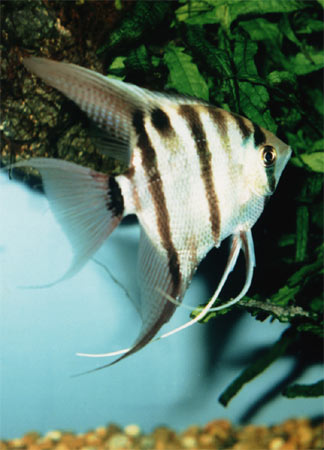|
"Wild Angelfish-Scalare." That's what the label on the tank
in the shop said, and they were just what I was looking for.

Alec's male Pterophyllum dumerilii. Note the iridescent
green area above and slightly behind the eye.
|
| Alec's male Pterophyllum dumerilii. Note the iridescent
green area above and slightly behind the eye. |
My 4-foot-long community tank had room for some new fishes.
It had been set up nearly four years, but in time the original
assortment of honey and chocolate gouramis had gone, one by one,
to the great fish tank in the sky. There were still fishes left-
eight large and boisterous Congo tetras, four large Pyrhulina
sp., some Corydoras catfish, a very old pearl gourami, two
loaches, and a few other innocuous small community fishes. But
now I had decided to buy some angels.
Like most hobbyists I had always assumed that there were just
two types of freshwater angelfish, "altum" and "scalare."
The fish in the tank at the shop looked a little peculiar,
but they were very small for wild-caught fish, mostly with a
body size around 1 1/2", so perhaps that was to be expected.
There were maybe 80 or more of them in the tank, and they had
the best assortment of broken fins I had ever seen, but they
looked full-bodied and lively. I bought six on the spot, and a
week later another two.
Two fish refused to feed and were separated, but the others
settled in with a will. My community tank is 48" x 18" x 16"; one
half has an undergravel filter, and the other half a "double"
sponge filter. There are a number of simulated wood ornaments,
including a 3-foot "log." The log and some of the other pieces
are covered in a thicket-a real thicket-of Java fern. One-fifth
of the water is changed weekly. The pH in the tank stays around
6.6 to 7.0. The tap water in our area is very soft-approximately
3 DH.
But to get back to the fish: having two refuse to eat caused
me concern and apprehension for the other, but the other six
never looked back. They ate and grew rapidly. They were fed
three times daily, twice on flake and tablets and once in the
evening with a typical beef heart based discus mix.

Female P. Dumerilii; note the
thick, blunt breeding tube.
|
| Female P.
Dumerilii; note the thick, blunt breeding
tube. |
There was no conflict between the angels and the other fishes
in the tank, but they did plenty of squabbling among themselves,
though no damage was done. Indeed, their torn and broken fins
healed up completely in a few weeks.
After buying the fish I continued to be rather puzzled over
their appearance. They seemed to have too many vertical bars
around the head and the snout just wasn't like any angelfish I
had seen, so it was off to the fish shop again!
I soon found the answer in the T.F.H. book Freshwater
Angelfish, by Dr. H. R. Axelrod and Dr. Warren E. Burgess. There
is another angelfish that is NOT just a synonym of Pterophyllum
scalare, and that is P. dumerilii. The authors also write that
the "altum" angelfish is in fact a subspecies of P. scalare, P.
scalare altum. The fish in my tank matched the description and
pictures of P. dumerilii exactly.
The simplest way to tell dumerilii from scalare is from the
vertical band that goes through the eyes. On a scalare this band
sweeps back to the dorsal fin, but in a dumerilii it just goes
straight over the top of the fish's forehead to the other eye.
There are other differences: dumerilii has a noticeable black
blotch just below the dorsal fin on one of the faint vertical
bars (although this varies greatly in intensity according to the
mood of the fish). The nose shapes differ, dumerilii being
rather longer and fuller; and a dumerilii has an extra vertical
band near the head. Also, dumerilii are smaller fish than
scalare, growing to a maximum of around 4" body length. Meristic
values vary, but you don't need to count scales to tell a
dumerilii.
The fish settled down and grew rapidly, and there were
interesting early changes of behavior. I had bought the first
six on 31 October 1987, and noted on 22 November (already!) that
the two largest--body size now about 2"--did not attack each
other. On 8 December the two began to clean up a leaf (even more
already!) Then nothing else--the two stayed friendly, and
cleaned up leaves regularly, but nothing else happened except
that they continued to grow.
On 16 February 1988 I upped the temperature from 75F to 82F,
at the same time stepped up the water changes and adding
blackwater extract.

The colors of the Alec's
breeders varied considerably;
here their bands have almost
disappeared.
|
| The
colors of the Alec's breeders varied
considerably; here their bands have almost
disappeared. |
By April the pair were about 2 1/2" body size. They spawned
on 14 April on a leaf in the center of the tank, about halfway
from gravel to surface. There were maybe 200 cream-colored eggs.
At that time the markings on the adults became very dark and
intense.
Interestingly, there had always been a distinctive difference
between what turned out to be the male and the female. There is
a blotch on the rear of the gill cover which runs onto the body.
On the male the had always been a bright blue-green, and on the
female it had been always black. On the non-paired fish the
blotch remained a pale green. When the fish's markings darkened
at breeding time this difference became blurred. From breeding
onward, this distinction was unfortunately lost--both fish since
that time have shown alternately black, blue, or green, or even
sometimes little blotching at all! I do not understand the
significance of this blotch, but it does seem to be an indicator
of mood or dominance.

The angels attend their eggs, which are attached to a java fern leaf.
|
| The angels attend their eggs, which are attached to a java fern leaf. |
The parents continued to guard them well--too well! Murder
was definitely in the offing. So on 21 April, just as it looked
as if the fry were about to become free-swimming, I removed
about 70 to a separate rearing tank, with their water, and those
that I missed became a snack to the other hungry fish in the
flurry. The parents were left in the community tank.

The angels attend their eggs, which are attached to a java fern leaf.
|
| The angels attend their eggs, which are attached to a java fern leaf. |
The fry started free swimming on 22 April and I began feeding
liquid and powdered fry food. The first thing the fry did upon
swimming was to rise to about 2" from the surface, and there
they stayed, shoaling loosely in the corner, only spreading out
as they grew bigger. The young were quite lively and seemed to
feed well.
Unfortunately, no doubt due to my failure to provide adequate
diet, after a few weeks great size differences began to occur.
The backward fry were culled and the numbers dwindled fast.
By 10 July I had decided that only five of the young were
good enough to keep. They had a body size of approximately 3/4".
They were given to a fellow fish keeper and they have done quite
well for him so far. Two appear to have paired off (December
1988), but so far they have not spawned for him.
Following the first spawning the parent fish repeated the
performance at 8-9 week intervals. Sometimes they spawned on
leaves, sometimes on the back glass. However, although the
spawnings hatched and the young were transferred successfully to
other leaves in the tank the fry all disappeared during the
night. I suspect they were scattered by my rather large loach.
In October of 1988 I decided to have another go at raising a
batch and set up the rearing tank again.

Close-up view of the fry on the leaf.
|
| Close-up view of the fry on the leaf. |
The fish spawned during the weekend of 30 October. I was away
at the time. The eggs hatched during that following Monday and
that evening about 120 were removed to the rearing tank. They
became free-swimming on Saturday, 5 November.
The adults stand watchful below their free-swimming fry, seen
roaming over the log.

The adults stand watchful below their free-swimming fry, seen roaming over the log.
|
| The adults stand watchful below their free-swimming fry, seen roaming over the log. |
This time they were fed mostly brine shrimp, with some liquid
fry food and a little powdered fry food. About 50 of the fry
seemed unable to take the newly hatched shrimp and were removed
during cleaning operations over the first few days. the other 70
fry took them heartily and have developed well.

Alec's breeding efforts paid off! -This is a juvenile P. dumerilii, picking at a sponge filter. With luck, more hobbyists will come to know this rare angelfish.
|
| The aurthor's breeding efforts paid off-this is a juvenile P. dumerilii, picking at a sponge filter. With luck, more hobbyists will come to know this rare angelfish. |
To produce enough brine shrimp, I used two one-gallon glass
jars, warmed to 75 on a hot plate device sold for home
winemaking. I started one off with clean, aerated salt water and
eggs each morning. This produced masses of shrimp nauplii daily,
which was just as well, because after three weeks I was having
to start off over half a teaspoon of eggs each day and still
supplement that with powdered flake food!
At three weeks the young fish began to take grated beef heart
mix as well, and after four weeks I stopped hatching shrimp. At
five weeks from free-swimming, the fry were as large as the
bigger fish of the first batch were at three months, and much
livelier.
Their fin development is excellent. Of the 70 only three are
unsatisfactory; the rest are very even in development. Not a
single fry that actually took brine shrimp has been lost.
In conclusion I would say that the small size of P. dumerilii
make it an excellent angelfish for community tanks. Their
attitude to other fishes is benign, except when breeding. They
are also loyal spouses and exhibit fascinating parental
behavior, but then, that seems true of so many pair-forming
cichlids!  |